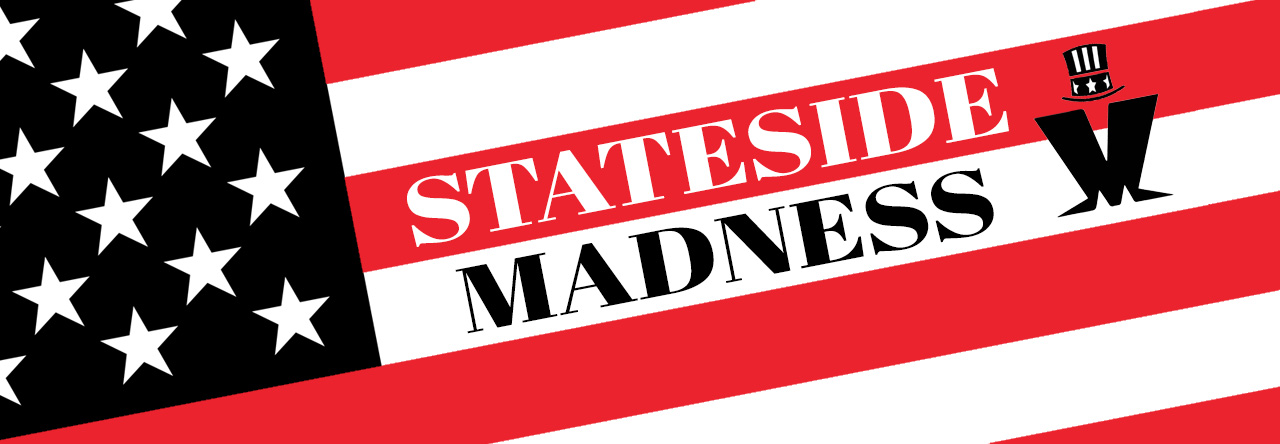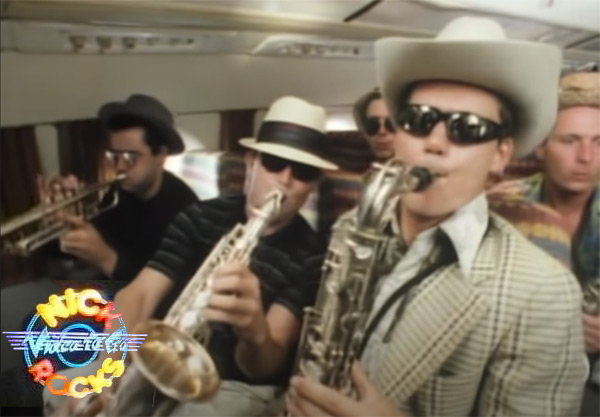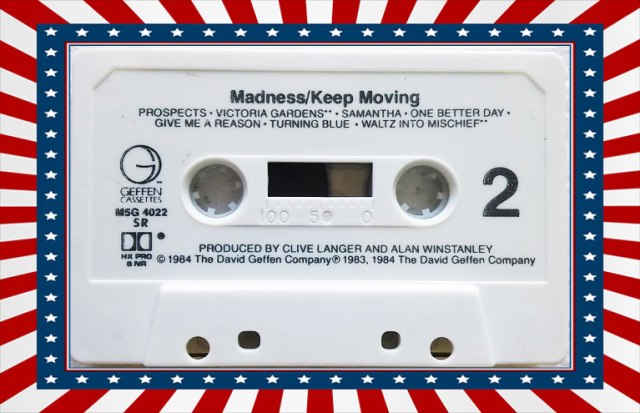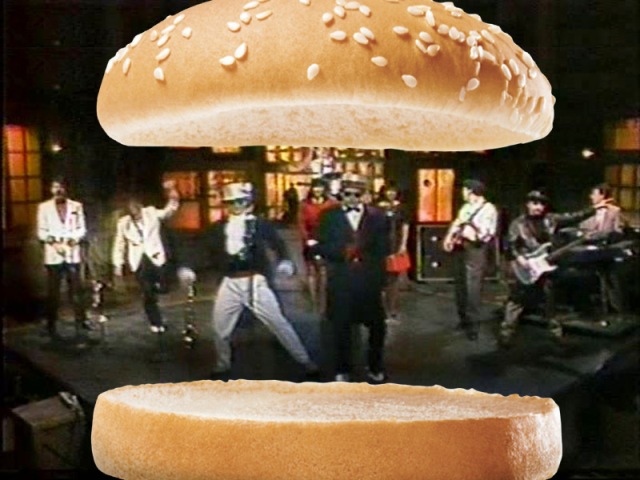
I was a Madness fan for a full year before I got to hear them play live. By that, I don’t mean live in person for the first time. Heavens, no – that took another 25 years, which is a story for a whole other blog post. I mean, it took a year before I got to hear any audiovisual media transmission of Madness properly performing live. And this first listen also happened to be literally live. From New York. It’s Saturday Night!
Madness made their historic appearance on Saturday Night Live on April 14, 1984. Before this, I had seem them on American TV shows like Solid Gold and American Bandstand, but they were always miming to the recorded tracks, same as they had to do on Top of the Pops. It is possible that I’d been exposed to quick clips of Madness playing live on some MTV profile or on USA Network’s Night Flight. The producers of that show were clearly partial to Madness and British ska, airing obscure stuff like the “One Step Beyond” video a lot. But footage of Madness live on stage was seemingly on embargo in this country.
In these dark ages, there were no Madness live albums for me to buy, no black market of Madness bootlegs at my disposal, no concert films on VHS, and definitely no access to the Madness U.S. tour dates of 1983-84 that may as well have been on the moon. So here Madness was, crowned as my new favorite band, even though I had no idea what they sounded like on stage.
It’s quite remarkable, when you consider how Madness earned their rapid rise to notoriety in the UK on the strength of their live show. Blowing the roofs off The Dublin Castle and The Hope and Anchor garnered their first London fans through sweat-soaked, boot-stomping word of mouth. Then the 2 Tone Tour and their first headlining tours got the rest of the country jumping on the nutty train. The hit singles and Top of the Pops secured their success, obviously, but their explosive energy on stage was what made Madness. It was quite the opposite scenario in the States, where we embraced the catchy “Our House” pop tune with zero conception of how this unassuming troupe of ragamuffins could rock the ever-loving shit out of a live audience.

So that’s why this Saturday Night Live gig was really a big deal. Even if it had been a whole year since their big hit in America, this was our chance to finally see and hear what Madness was capable of live, on U.S. pop culture’s most high-profile live stage. The band had played a few California dates and visited Dick Clark in February-March 1984, an eventful swing that saw Lee marry his wife Debbie in Los Angeles. Madness flew back from Paris to New York for Saturday Night Live in April.
The host for their week was no Steve Martin or George Carlin – it was 1972 Democratic Presidential nominee George McGovern, who ran against Nixon and lost. He was still relevant in 1984 since he’d been running for the Democratic nomination again, but had just dropped out in March. For some reason Dick Ebersol thought a failure-ridden politician with no discernible personality would be comedy gold. Spoiler alert: he wasn’t.
Infinitely more in tune with the 1984 zeitgeist was SNL’s other special guest that night, none other than Clara Peller. For the benefit of the youngsters, the 81-year-old Mrs. Peller was the famed “Where’s the beef?” lady from the Wendy’s ad campaign that debuted at the start of that year. America was in the grips of “Where’s the beef?” fever when this show aired, and in fact Senator McGovern was fresh from participating in the Democratic primary debate where Walter Mondale borrowed Clara’s catchphrase as a zinger against Gary Hart. Good times.
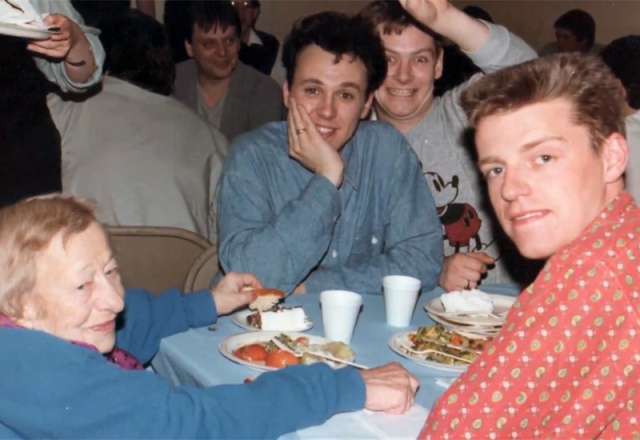
Clara got to meet Madness before their joint Saturday Night Live broadcast and even had dinner with the band. Presumably adequate cow meat was offered on the bill of fare. Believe it or not, a 2015 biographical musical called Clara and the Beef chronicled her stardom in song, with one number devoted to her SNL exploits. “Saturday Night In New York” is very much a pastiche of “Our House,” with a faux-nutty rhythm bounding along to stupefying lyrics like “I will wear my new mink, please please don’t blink, I can be so special it’s a rare treat, and quite a feat – you need to let me go, on with the show!”
On that big SNL show, Clara’s main bit was a cameo at the end of a blah sketch about unappetizing TV dinners for impoverished Reaganomics victims. “Where’s the beef? Where’s the beef?” she repeatedly inquired, to roars of adulation. Later Clara stepped out with George McGovern to co-introduce the musical guest.

“Where’s the band?” demanded the marketing icon, squinting all around the studio. As raucous applause subsided, McGovern helpfully pointed out, “Clara, they’re right over there, and they’re called Madness.”
And now at last, the boys took the stage live in front of America. They dressed well for the occasion, with Woody in a middle-management necktie and short sleeves, Mark and Chris looking snazzy in their flat caps, Lee and trumpet sideman Dick Cuthell coordinated in white dinner jackets, and the gaudy duo of Suggs and Carl sporting Victorian tailcoats, lapel carnations and vintage costume hats. Suggs’s dark outfit was accented in red, while Carl opted for a monochromatic look complete with silvertone facepaint, making him look transplanted from a black and white film. The band was fleshed out with James Mackie manning Barso’s abandoned post and a trio of ladies on backing vocals.
The first Madness tune of the evening was, of course, “Our House.” Even though it had grown old and gray by this point and they had new music to promote, they knew well enough to give the Yanks what we wanted. Indeed, the studio audience showered them with a warm reception, even working up enthusiasm for the dreaded new song, the title track from the spanking new Keep Moving – which maybe two people in that crowd had heard, along with the loyal fans tuning in like me. By now, you’re thinking I must have been pretty stoked, right?
To be honest, I wasn’t that impressed. I came away from the SNL show with the disappointed assessment that Madness wasn’t that great of a live band.

Shocking, I know! Let me hasten to add, the performance wasn’t that bad. Unfortunately there are no clips readily available online, since NBC Universal guards their copyrights with an iron fist, so I can’t let you judge for yourself. I do have private recordings, though. Watching them now, I can say the band was rather solid instrumentally. Mackie is no Mike Barson on the keys, but of course no one is. What soured the Saturday Night Live spotlight for me was our vocalists.
Suggs let me down because he didn’t seem to be into it. His charming expressiveness in the band’s music videos had made him my fast favorite member of the band, but live from New York, his affect struck me as flat and disinterested. Not much passion or dynamic range in his voice, compared to Madness recordings. Toward the end of “Our House,” Suggs went into “was our castle and our keep” one bar too soon. Perhaps a few too many beverages or other SNL vices before the show?
And Carl pissed me off, too. At this point in time, I regarded Chas Smash as just a backup vocalist who sang lead on a few songs. To me Suggs was THE singer of Madness. I didn’t much like seeing Carl showboating up front when it wasn’t one of his songs, like he was trying to crowd out Suggs as the frontman. With Suggs playing it so low-key, Carl’s voice was totally dominant at times. I wished Carl was hanging out back there with Lee and the backup girls instead. Speaking of whom, those ladies weren’t helping things. The one spot where they fit in was “Sister’s sighing in her sleep, ah-ah-ah ahhh.” Otherwise their chirps just cluttered up the vocal shambles even more.
Like dear Clara Peller, I asked myself, “Where’s the band?”

Since I didn’t own a VCR until Christmas 1984, I had no record of that SNL show to play back. In my memories, this live Madness exhibition degenerated into a Rashomon grotesque of musical ineptitude. I recollected the whole band as sounding terrible, when that wasn’t at all true. This perceived blunder didn’t tarnish my opinion of Madness, though. I still loved them, I just decided they were a great studio band and not so hot on stage. No harm, no foul. I wasn’t disabused of this faulty notion for a couple of years – I believe it was finding the Dance Craze LP (yet another tale for a future blog) that demonstrated how Madness was without question an extraordinary live act.
In my defense, I can offer the court three pleas for why Madness on Saturday Night Live hit me the wrong way. First off, I was just a kid. And mighty clueless in oh so many ways. At age 14, I hadn’t even been to a single rock or pop concert, just country music shows with my mom. My yardstick for grading live music was how closely it sounded like the record, lacking mature appreciation for nuances of rawness and spontaneity.
Secondly, there was a bit of sour grapes involved. With the prospects of me seeing a Madness concert seeming astronomically remote, I suppose some recess of my subconscious was glad to find fault with Madness on stage. Convincing myself that they maybe kinda sucked at playing live was a coping mechanism against teenage FOMO.
Most importantly, this is a case of what statisticians might call error from insufficient data sampling. When you’ve seen a performing artist a thousand times, you can readily identify and forgive a misstep here and there. But when making a critical evaluation based on one showing, you can jump to all sorts of false conclusions. So Suggs wasn’t on top form that night. So I was ignorant of Carl’s evolved stage dynamics. So the backup singers weren’t the best. It sure doesn’t mean Madness can’t play live, but I was working from the best evidence at hand. As a kid still learning about the wide world, I was prone to making sweeping generalizations based on my narrow personal frame of reference. Hell, I’m guilty of doing that nowadays, but hopefully not as often. Or as stupidly.
Looking back, it’s ironic that one of the first Madness songs I heard live (on TV) happened to be “Keep Moving.” Some thirty years later, when I went to the 2015 House of Fun Weekender, the first tune in the Friday night fan-service setlist was “Keep Moving.” A song I never, ever, EVER dreamed I would see Madness play live (in person). As I pumped my fist in Minehead and screamed mine head off, any foolish misgivings about this band’s live musicianship were forgotten like a silly old nightmare.
Don’t hide from past folly. Hold it high with a smile. Speak out loud with the mind of a child. If you’re lucky.
Special thanks to Declan McDermott for his archival assistance.
Other sources: Madness on TV, Bronwyn Douwsma
